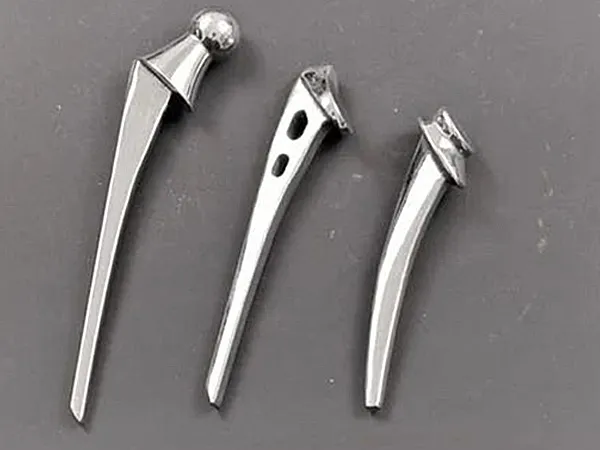Titanium began to be used in orthopedic implants about 70 years ago. With technological advances and the growing popularity of titanium alloys, the metal was used to develop shoulder and hip sockets. Even dental implants and hearing aids, which are made of titanium, have a longer service life compared to other materials.

Titanium, a common choice for orthopedic implants
Manufacturers are beginning to recognize the natural properties that this metal must have and have started using titanium for orthopedic implants. It has an incredible strength/weight ratio, excellent corrosion resistance, and most importantly, it is 100% biocompatible.
It was soon discovered that titanium even facilitated the process of osseointegration, forming a physical bond with the bone (without the need for other adhesive substances). In addition, it was established that titanium implants can withstand high energy (without fracture). They do not react to the environment in which they are placed for a long time (in some cases they do not need to be replaced).
Today, titanium is used not only for internal fixation, but also for prosthetics, medical devices and internal devices. There are a number of alloys that are preferred for both medical and dental implants, such as Ti-6Al-4V and Ti-6Al-4V ELI.These are alpha-beta alloys usually alloyed with aluminum and vanadium. They provide a high level of fracture resistance, not to mention that they promote osseointegration (faster recovery).
Titanium is known to be an inert metal, thanks to the protective oxide film that forms when exposed to oxygen (which occurs naturally). This metal is resistant to damage caused by bodily fluids and tissues, which means it is not rejected by our bodies.
As a result, you'll see titanium used in skull plates, elbow and knee joints, and even ribs. Bone screws, staples and cables can be made from titanium. All orthopedic implants made from titanium provide excellent support for fractured bones, thus facilitating the fixation process.
New titanium alloys for orthopedic implants
For orthopedic implants, beta titanium alloys have been attracting a lot of attention because of their good formability and excellent mechanical properties. They offer impressive corrosion resistance, as well as high levels of mechanical and fatigue strength.
One of the main reasons for the use of beta titanium alloys for orthopedic implants is their low elastic modulus. Recently, a new beta alloy - Ti-35Nb-7Zr-5Ta - has been developed for such applications.The alloy is produced by powder metallurgy and has a porous structure, making it a suitable choice for successful osseointegration.
Titanium elastic nailing system for treatment of long bone fractures in children
The titanium elastic nail system (TEN) described is intended for the fixation of diaphyseal fractures of long bones. Such bones have narrow medullary canals, so it is important to be able to use a flexible implant.TEN is preferred because it reduces the risk of complications.
The main benefit of using the titanium elastic nail system is immediate stabilization after surgery. This permits early mobilization of the involved part, allowing the patient to return to normal activities in a shorter period of time. In addition, this orthopedic implant has a low complication rate and is a minimally invasive procedure.
It can be used for pediatric fractures in children between the ages of 5 and 14. The system is safe and reliable and is recommended for long bones. The intervention time is short, the recovery is quick and the functional prognosis is good.
Thanks to the TEN, patients can bear weight early and heal quickly he with minimal disruption of bone growth. It is also worth mentioning that the Titanium Elastic Nailing System can be used for such fractures regardless of their location or style.

Vertical Expandable Prosthetic Titanium Rib
The prosthetic titanium rib described is an innovative device designed to stabilize two pediatric chest wall deformities of the spine and ribs. The curved metal rods are intended to improve breathing and are also recommended for the treatment of severe scoliosis. Medical experts have also used titanium ribs (involving the removal of multiple ribs) in children who need chest reconstruction after cancer surgery.
Children diagnosed with Thoracic Insufficiency Syndrome can also benefit from prosthetic titanium ribs. The device straightens the spine and separates the ribs, allowing the lungs to expand more efficiently in the newly created space. Furthermore, it stabilizes the diaphragm, the muscle used for breathing.
The artificial titanium ribs will adjust to each child and his or her needs. It is important to understand that the device is expandable. As the child grows, new interventions will be made to increase body length.
Titanium nanotubes allow for more effective osseointegration
Titanium nanotubes could improve the osseointegration of orthopedic implants while reducing the risk of bacterial colonization. With this discovery, the researchers enhanced the surface of titanium implants with titanium nanotubes.
Orthopedic implants treated with titanium dioxide nanotubes ensure more effective osseointegration. As a result, the bond between the implant and the bone is strengthened. Early weight-bearing is very good in patients who have received such implants.
Graphene-coated titanium alloy - more effective osteogenesis and osseointegration
Graphene-coated titanium alloys can actually enhance their surface bioactivation, which will further support effective osteogenesis and osseointegration processes. The graphene coating of titanium alloys improves the biocompatibility of titanium alloys, promotes bone tissue regeneration and improves bone-implant integration.
Graphene is an innovative nano-coating material that promotes the bioactivity of titanium alloys and facilitates the aforementioned processes. The orthopedic implant has high mechanical strength and fracture toughness, is corrosion resistant and 100% biocompatible.


